2004 FORD EXPEDITION air conditioning
[x] Cancel search: air conditioningPage 1 of 344

Introduction 4
Instrument Cluster 10
Warning and control lights 10
Gauges 14
Entertainment Systems 17
AM/FM stereo cassette with CD 17
Rear seat controls 27
Rear seat entertainment system 32
Navigation system 44
Climate Controls 80
Manual heating and air conditioning 80
Rear passenger climate control 85
Rear window defroster 86
Lights 87
Headlamps 87
Turn signal control 90
Bulb replacement 91
Driver Controls 99
Windshield wiper/washer control 99
Power windows 105
Mirrors 106
Speed control 108
Message center 119
Locks and Security 132
Keys 132
Locks 132
Anti-theft system 133
2004 Expedition(exd)
Owners Guide (post-2002-fmt)
USA English(fus)
Table of Contents
Table of Contents
1
Page 80 of 344
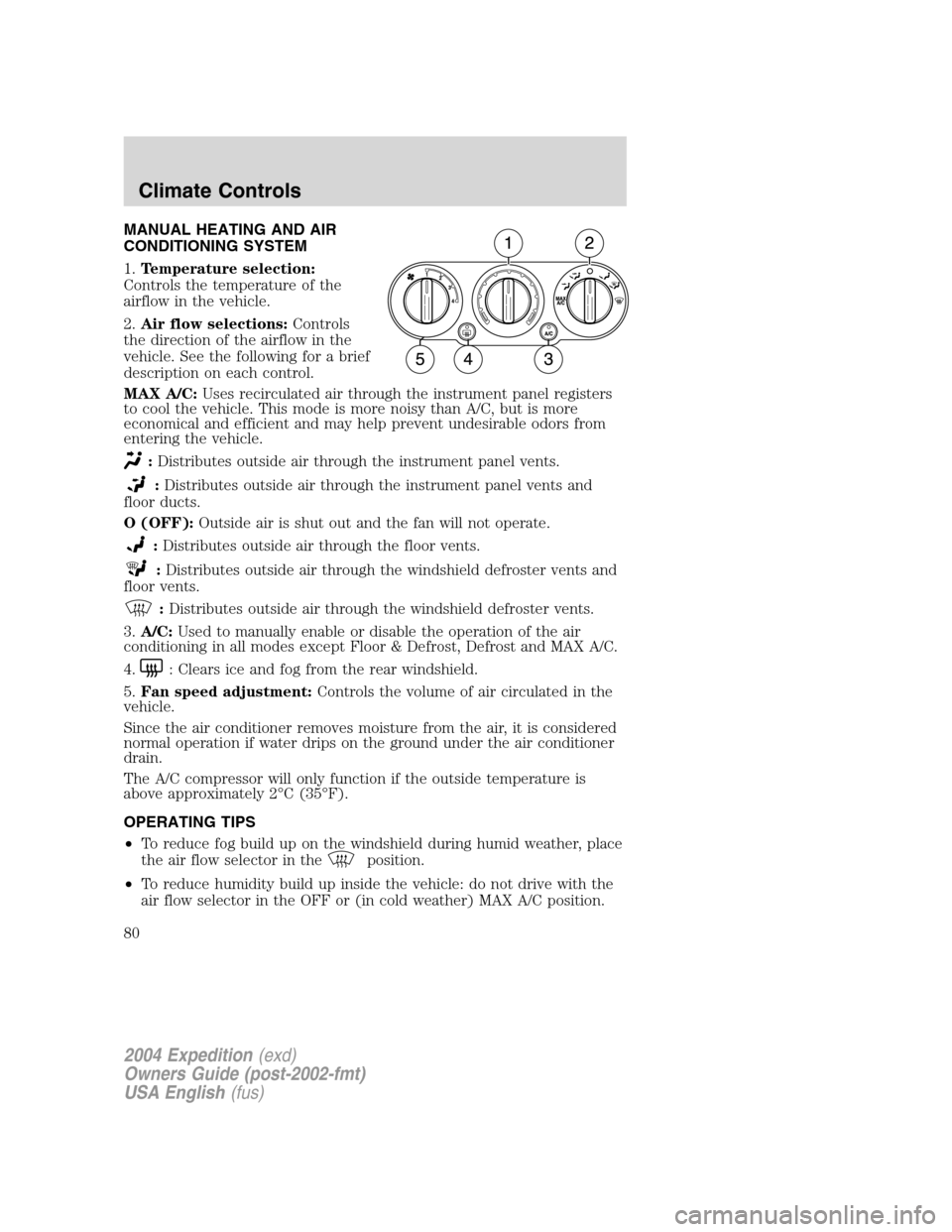
MANUAL HEATING AND AIR
CONDITIONING SYSTEM
1.Temperature selection:
Controls the temperature of the
airflow in the vehicle.
2.Air flow selections:Controls
the direction of the airflow in the
vehicle. See the following for a brief
description on each control.
MAX A/C:Uses recirculated air through the instrument panel registers
to cool the vehicle. This mode is more noisy than A/C, but is more
economical and efficient and may help prevent undesirable odors from
entering the vehicle.
:Distributes outside air through the instrument panel vents.
:Distributes outside air through the instrument panel vents and
floor ducts.
O (OFF):Outside air is shut out and the fan will not operate.
:Distributes outside air through the floor vents.
:Distributes outside air through the windshield defroster vents and
floor vents.
:Distributes outside air through the windshield defroster vents.
3.A/C:Used to manually enable or disable the operation of the air
conditioning in all modes except Floor & Defrost, Defrost and MAX A/C.
4.
: Clears ice and fog from the rear windshield.
5.Fan speed adjustment:Controls the volume of air circulated in the
vehicle.
Since the air conditioner removes moisture from the air, it is considered
normal operation if water drips on the ground under the air conditioner
drain.
The A/C compressor will only function if the outside temperature is
above approximately 2°C (35°F).
OPERATING TIPS
•To reduce fog build up on the windshield during humid weather, place
the air flow selector in the
position.
•To reduce humidity build up inside the vehicle: do not drive with the
air flow selector in the OFF or (in cold weather) MAX A/C position.
2004 Expedition(exd)
Owners Guide (post-2002-fmt)
USA English(fus)
Climate Controls
Climate Controls
80
Page 118 of 344

Compass zone adjustment
1. Determine which magnetic zone
you are in for your geographic
location by referring to the zone
map.
2. Turn ignition to the ON position.
3. Start the engine.
4. Press the TRIP/RESET button
(near your odometer display), hold
for six seconds and release. You will
see that ZONE appears in the
instrument cluster display.
5. Press and release the button until
the desired zone number appears.
Note:The range of zone values are from 01 to 15 and“wraps”back to
01.
6. When you get to the desired ZONE number, hold the TRIP/RESET
button down to“lock in”the new value.
The cluster display will return to the“normal”mode when the
TRIP/RESET button has not been pressed for 6 seconds.
Compass calibration adjustment
Perform this adjustment in an open area free from steel structures and
high voltage lines. For optimum calibration, turn off all electrical
accessories (heater/air conditioning, wipers, etc.) and make sure all
vehicle doors are shut.
1. Start the vehicle.
2. To enter the compass calibration
mode, press and hold the
TRIP/RESET button for greater than
eight seconds. The display will then
show CAL in the display window.
1 2 3
4
5
6 7 8 9 101112 13 14 15
2004 Expedition(exd)
Owners Guide (post-2002-fmt)
USA English(fus)
Driver Controls
118
Page 121 of 344
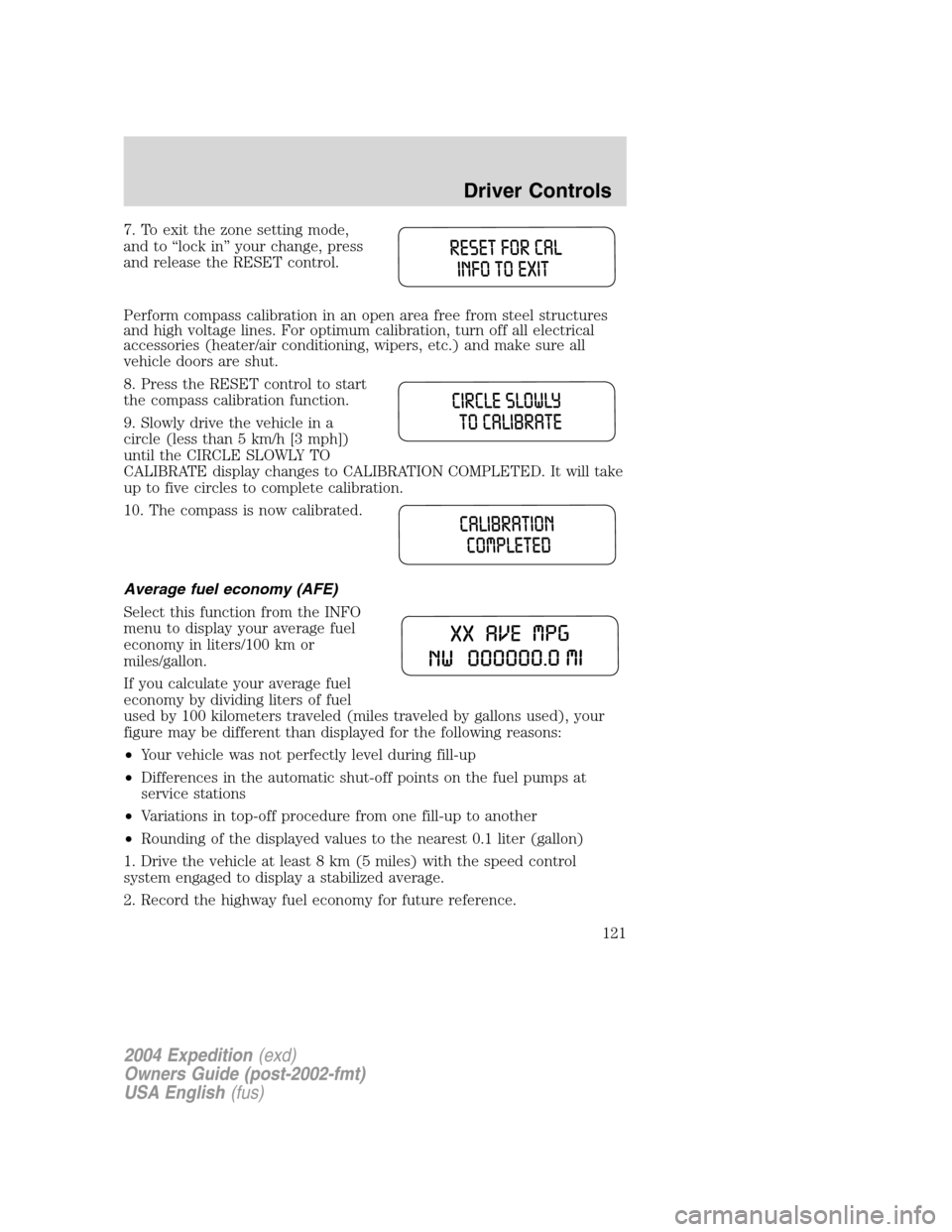
7. To exit the zone setting mode,
and to“lock in”your change, press
and release the RESET control.
Perform compass calibration in an open area free from steel structures
and high voltage lines. For optimum calibration, turn off all electrical
accessories (heater/air conditioning, wipers, etc.) and make sure all
vehicle doors are shut.
8. Press the RESET control to start
the compass calibration function.
9. Slowly drive the vehicle in a
circle (less than 5 km/h [3 mph])
until the CIRCLE SLOWLY TO
CALIBRATE display changes to CALIBRATION COMPLETED. It will take
up to five circles to complete calibration.
10. The compass is now calibrated.
Average fuel economy (AFE)
Select this function from the INFO
menu to display your average fuel
economy in liters/100 km or
miles/gallon.
If you calculate your average fuel
economy by dividing liters of fuel
used by 100 kilometers traveled (miles traveled by gallons used), your
figure may be different than displayed for the following reasons:
•Your vehicle was not perfectly level during fill-up
•Differences in the automatic shut-off points on the fuel pumps at
service stations
•Variations in top-off procedure from one fill-up to another
•Rounding of the displayed values to the nearest 0.1 liter (gallon)
1. Drive the vehicle at least 8 km (5 miles) with the speed control
system engaged to display a stabilized average.
2. Record the highway fuel economy for future reference.
2004 Expedition(exd)
Owners Guide (post-2002-fmt)
USA English(fus)
Driver Controls
121
Page 200 of 344
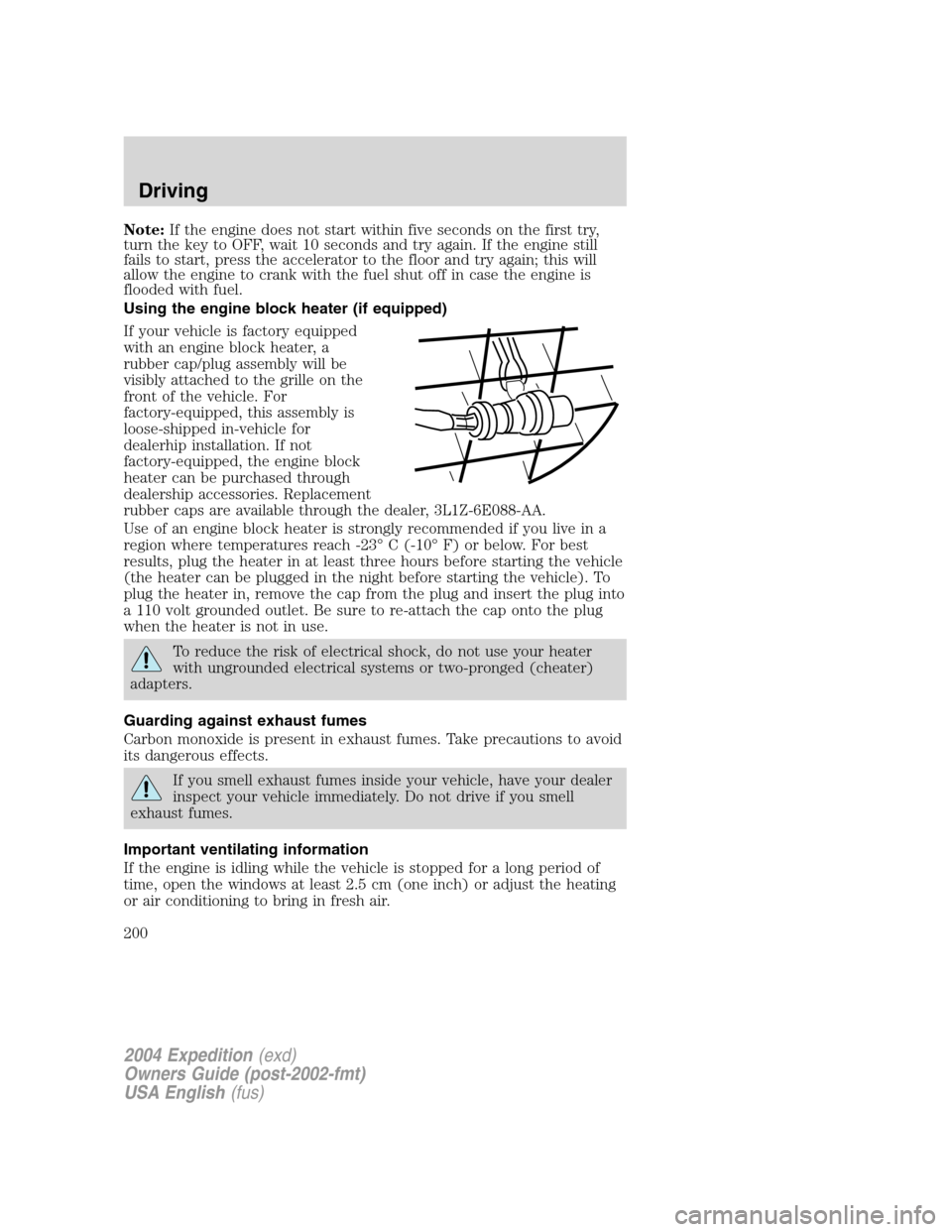
Note:If the engine does not start within five seconds on the first try,
turn the key to OFF, wait 10 seconds and try again. If the engine still
fails to start, press the accelerator to the floor and try again; this will
allow the engine to crank with the fuel shut off in case the engine is
flooded with fuel.
Using the engine block heater (if equipped)
If your vehicle is factory equipped
with an engine block heater, a
rubber cap/plug assembly will be
visibly attached to the grille on the
front of the vehicle. For
factory-equipped, this assembly is
loose-shipped in-vehicle for
dealerhip installation. If not
factory-equipped, the engine block
heater can be purchased through
dealership accessories. Replacement
rubber caps are available through the dealer, 3L1Z-6E088-AA.
Use of an engine block heater is strongly recommended if you live in a
region where temperatures reach -23°C (-10°F) or below. For best
results, plug the heater in at least three hours before starting the vehicle
(the heater can be plugged in the night before starting the vehicle). To
plug the heater in, remove the cap from the plug and insert the plug into
a 110 volt grounded outlet. Be sure to re-attach the cap onto the plug
when the heater is not in use.
To reduce the risk of electrical shock, do not use your heater
with ungrounded electrical systems or two-pronged (cheater)
adapters.
Guarding against exhaust fumes
Carbon monoxide is present in exhaust fumes. Take precautions to avoid
its dangerous effects.
If you smell exhaust fumes inside your vehicle, have your dealer
inspect your vehicle immediately. Do not drive if you smell
exhaust fumes.
Important ventilating information
If the engine is idling while the vehicle is stopped for a long period of
time, open the windows at least 2.5 cm (one inch) or adjust the heating
or air conditioning to bring in fresh air.
2004 Expedition(exd)
Owners Guide (post-2002-fmt)
USA English(fus)
Driving
200
Page 295 of 344
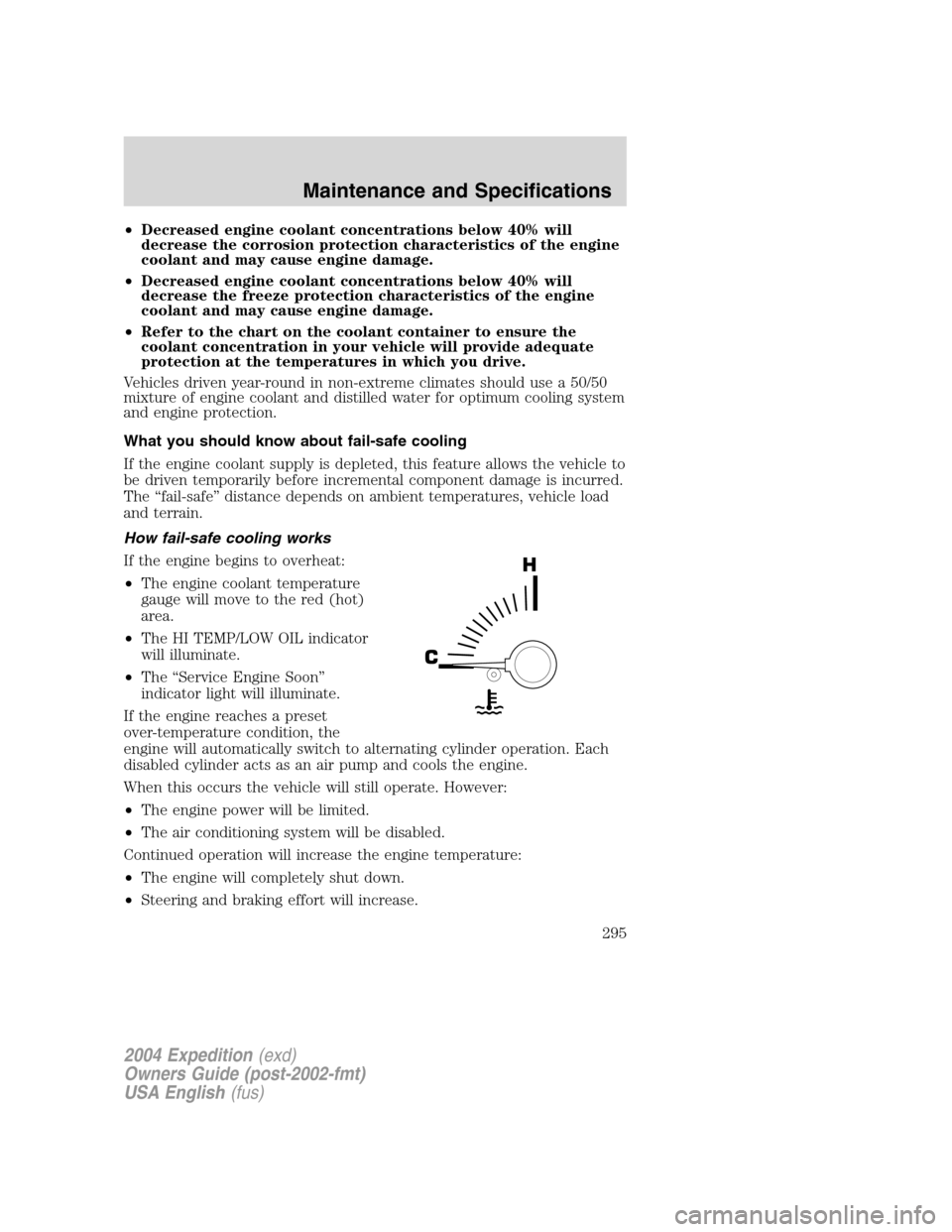
•Decreased engine coolant concentrations below 40% will
decrease the corrosion protection characteristics of the engine
coolant and may cause engine damage.
•Decreased engine coolant concentrations below 40% will
decrease the freeze protection characteristics of the engine
coolant and may cause engine damage.
•Refer to the chart on the coolant container to ensure the
coolant concentration in your vehicle will provide adequate
protection at the temperatures in which you drive.
Vehicles driven year-round in non-extreme climates should use a 50/50
mixture of engine coolant and distilled water for optimum cooling system
and engine protection.
What you should know about fail-safe cooling
If the engine coolant supply is depleted, this feature allows the vehicle to
be driven temporarily before incremental component damage is incurred.
The“fail-safe”distance depends on ambient temperatures, vehicle load
and terrain.
How fail-safe cooling works
If the engine begins to overheat:
•The engine coolant temperature
gauge will move to the red (hot)
area.
•The HI TEMP/LOW OIL indicator
will illuminate.
•The“Service Engine Soon”
indicator light will illuminate.
If the engine reaches a preset
over-temperature condition, the
engine will automatically switch to alternating cylinder operation. Each
disabled cylinder acts as an air pump and cools the engine.
When this occurs the vehicle will still operate. However:
•The engine power will be limited.
•The air conditioning system will be disabled.
Continued operation will increase the engine temperature:
•The engine will completely shut down.
•Steering and braking effort will increase.
2004 Expedition(exd)
Owners Guide (post-2002-fmt)
USA English(fus)
Maintenance and Specifications
295
Page 339 of 344
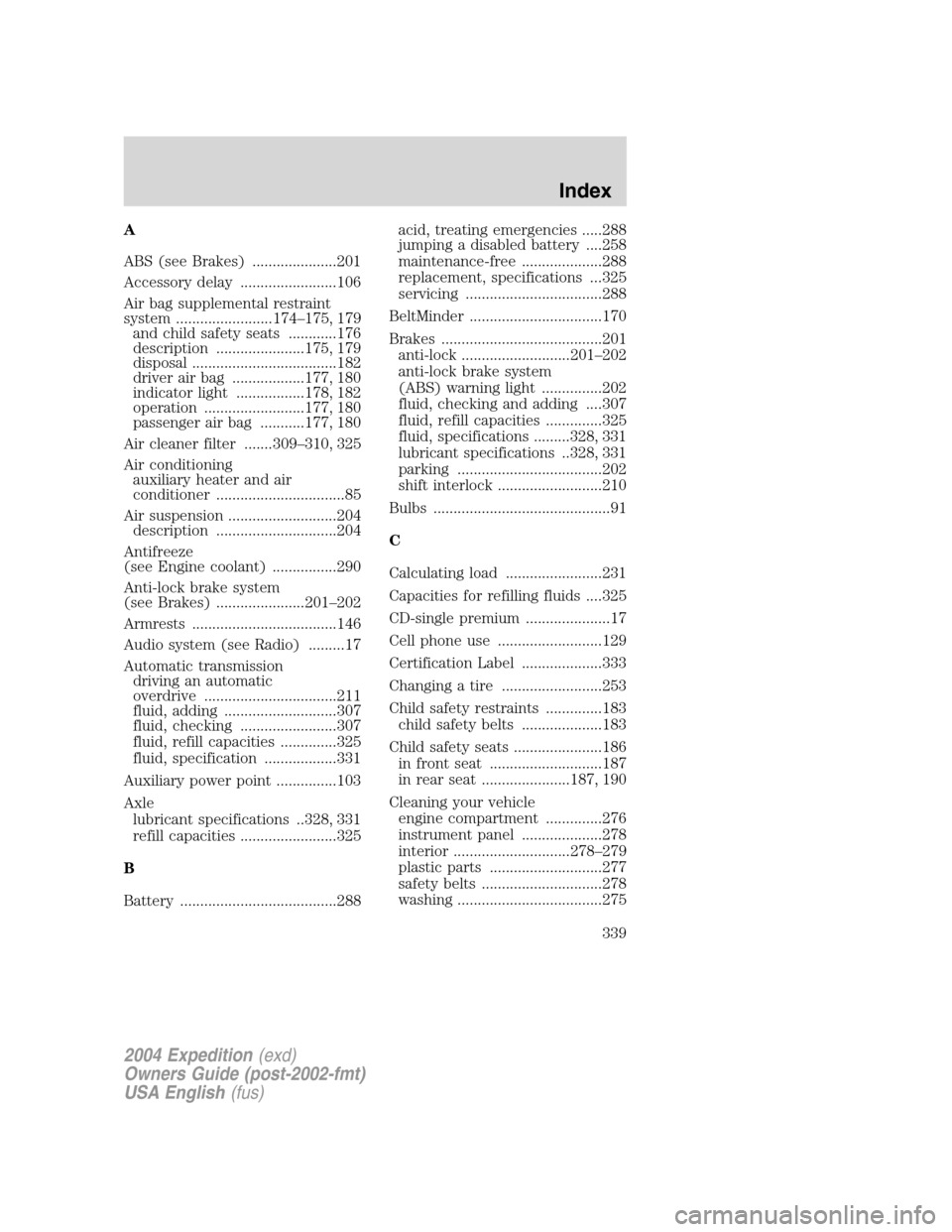
A
ABS (see Brakes) .....................201
Accessory delay ........................106
Air bag supplemental restraint
system ........................174–175, 179
and child safety seats ............176
description ......................175, 179
disposal ....................................182
driver air bag ..................177, 180
indicator light .................178, 182
operation .........................177, 180
passenger air bag ...........177, 180
Air cleaner filter .......309–310, 325
Air conditioning
auxiliary heater and air
conditioner ................................85
Air suspension ...........................204
description ..............................204
Antifreeze
(see Engine coolant) ................290
Anti-lock brake system
(see Brakes) ......................201–202
Armrests ....................................146
Audio system (see Radio) .........17
Automatic transmission
driving an automatic
overdrive .................................211
fluid, adding ............................307
fluid, checking ........................307
fluid, refill capacities ..............325
fluid, specification ..................331
Auxiliary power point ...............103
Axle
lubricant specifications ..328, 331
refill capacities ........................325
B
Battery .......................................288acid, treating emergencies .....288
jumping a disabled battery ....258
maintenance-free ....................288
replacement, specifications ...325
servicing ..................................288
BeltMinder .................................170
Brakes ........................................201
anti-lock ...........................201–202
anti-lock brake system
(ABS) warning light ...............202
fluid, checking and adding ....307
fluid, refill capacities ..............325
fluid, specifications .........328, 331
lubricant specifications ..328, 331
parking ....................................202
shift interlock ..........................210
Bulbs ............................................91
C
Calculating load ........................231
Capacities for refilling fluids ....325
CD-single premium .....................17
Cell phone use ..........................129
Certification Label ....................333
Changing a tire .........................253
Child safety restraints ..............183
child safety belts ....................183
Child safety seats ......................186
in front seat ............................187
in rear seat ......................187, 190
Cleaning your vehicle
engine compartment ..............276
instrument panel ....................278
interior .............................278–279
plastic parts ............................277
safety belts ..............................278
washing ....................................275
2004 Expedition(exd)
Owners Guide (post-2002-fmt)
USA English(fus)
Index
Index
339
Page 341 of 344

F
Fail safe cooling ........................295
Floor mats .................................130
Fluid capacities .........................325
Foglamps .....................................87
Four-Wheel Drive vehicles .......217
control trac .............................217
description ..............................218
driving off road .......................220
electronic shift ........................219
indicator light .........................217
preparing to drive your
vehicle .....................................207
Fuel ............................................296
calculating fuel
economy ..........................121, 300
cap ...........................................298
capacity ...................................325
choosing the right fuel ...........299
comparisons with EPA fuel
economy estimates .................303
detergent in fuel .....................300
filling your vehicle
with fuel ..................296, 298, 301
filter, specifications ........300, 325
fuel pump shut-off switch .....240
improving fuel economy ........300
octane rating ...................299, 331
quality ......................................299
running out of fuel .................300
safety information relating
to automotive fuels ................296
Fuses ..................................242–243
G
Garage Door Opener
(see Homelink wireless
control system) .........................113Gas cap (see Fuel cap) ............298
Gas mileage
(see Fuel economy) .................300
Gauges .........................................14
GAWR (Gross Axle
Weight Rating) ..........................229
calculating ...............................231
definition .................................229
driving with a heavy load ......229
location ....................................229
GVWR (Gross Vehicle
Weight Rating) ..........................229
calculating .......................229, 231
definition .................................229
driving with a heavy load ......229
location ....................................229
H
Hazard flashers .........................240
Headlamps ...................................87
aiming ........................................89
autolamp system .......................87
bulb specifications ....................92
daytime running lights .............88
flash to pass ..............................88
high beam .................................88
replacing bulbs .........................93
turning on and off ....................87
Heating
heating and air conditioning
system .......................................80
HomeLink universal
transceiver (see
Garage door opener) ................116
Homelink wireless control
system ........................................113
Hood ..........................................282
I
Ignition ...............................197, 331
2004 Expedition(exd)
Owners Guide (post-2002-fmt)
USA English(fus)
Index
341